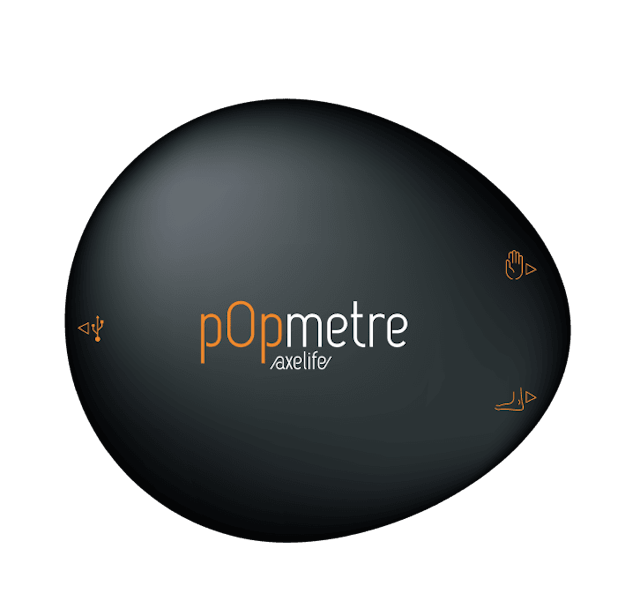Pulse Wave Velocity (PWV): Beyond the Framingham Score
The Framingham score is a well-recognized tool for assessing a patient's cardiovascular risk, taking into account factors such as age, gender, blood pressure, cholesterol, and smoking. However, it does not directly consider the structural and functional health of the arteries. For this purpose, the measurement of pulse wave velocity (PWV) offers a crucial complementary perspective, and it is now proven that it allows for earlier and more accurate identification of patients at the highest risk of cardiovascular and neurovascular events.
The Importance of the Pulse Wave Velocity in Cardiovascular Assessment
PWV is a biomarker for arterial stiffness, indicating the speed at which pressure waves generated by the heart propagate through the arteries. A high PWV is associated with increased arterial stiffness, which in turn is linked to a higher cardiovascular risk independent of other factors.
Reference values for PWV have been the subject of numerous publications, notably by a joint group of members from the ESH (European Society of Hypertension) and the ESC (European Society of Cardiology) called "The Reference Values for Arterial Stiffness' Collaboration." They have established age-specific and blood pressure category-specific values that are now used by all devices measuring PWV.
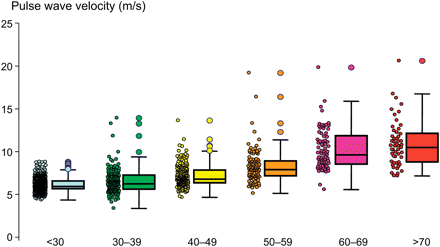
This collaboration has played a crucial role in standardizing PWV measurements, making it a reliable and consistent tool for assessing arterial health. The reference values they have provided allow for a more accurate interpretation of PWV readings, enabling healthcare professionals to better assess cardiovascular risk and tailor management strategies accordingly. These values help in distinguishing between normal and elevated levels of arterial stiffness, thus facilitating early intervention and management of individuals at risk of cardiovascular diseases.
According to this study, early vascular aging is associated with an increased cardiovascular risk, whereas individuals identified as SUPERNOVA presented a reduced rate of cardiovascular events compared to those with normal vascular aging.
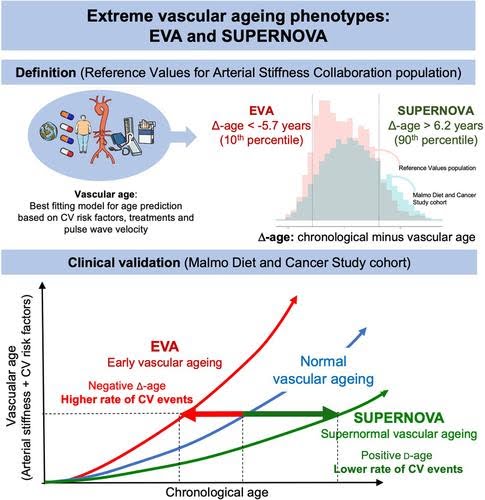
The concept of "arterial age," used by Axelife in its medical device, has shown its importance in numerous studies for improving healthcare provider-patient communication and supporting patients in making hygienic and dietary behavior changes.
By incorporating PWV into the overall risk assessment, physicians can detect early signs of cardiovascular diseases, even in patients who might otherwise be considered at moderate or low risk.
Utilizing the concept of arterial age, healthcare professionals have a powerful tool for both themselves and their patients to improve communication and support changes in hygienic and dietary behaviors. This approach emphasizes the importance of a more personalized risk assessment, enabling a better understanding of an individual's cardiovascular health and fostering proactive management strategies to mitigate risk factors.
How Pulse Wave Velocity Complements the Framingham Score ?
In 2022, the prognostic value of arterial stiffness was validated in a study conducted on the Framingham cohort, a reference in the cardiovascular field.
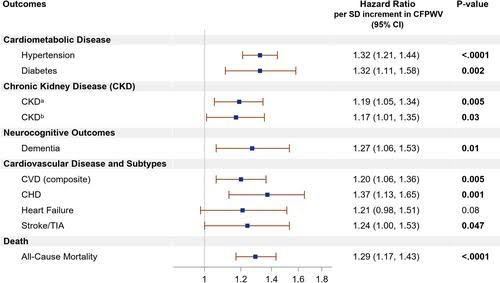
"Conclusion: Our prospective observations of a large community sample establish the long-term prognostic importance of arterial stiffness for multiple health outcomes."
In another study published by the AHA, the results show that PWV is associated with cardiovascular mortality and morbidity independently of traditional risk equations, but not independently of traditional cardiovascular risk factors.
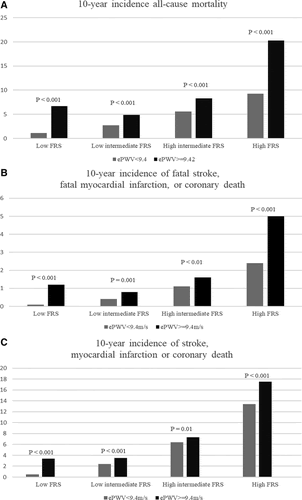
Figure 2. Ten-year incidence rates by estimated pulse wave velocity (ePWV; <9.4 m/s = low and ≥9.4 m/s = high) and Framingham Risk Score (FRS) category for (A) all-cause mortality, (B) fatal stroke or death from coronary heart disease (cardiovascular mortality), and (C) fatal or non-fatal stroke, death from coronary heart disease, or non-fatal myocardial infarction (composite endpoint). FRS low (estimated 10-year risk of broader composite cardiovascular outcome <10%), low-intermediate (10%≤ and <15%), intermediate-high (15%≤ and <20%), or high (≥20%).
Measuring PWV seems particularly interesting for the "FRS Low" and "FRS High" score categories, which can thus benefit from earlier and more precise detection to improve and personalize therapeutic and non-therapeutic interventions.
While the Framingham score remains a cornerstone of cardiovascular risk assessment, PWV enriches our understanding by adding an additional dimension: that of arterial health through ongoing vascular remodeling.
The joint use of these two measures allows healthcare professionals to create more targeted and personalized preventive and therapeutic strategies, potentially more effective for the prevention of cardio-neurovascular diseases.
Arterial age measured by PWV thus becomes a vital indicator for guiding clinical decisions.
PWV allows for going beyond the Framingham score by enabling:
Early Detection: PWV can reveal arterial stiffness before the appearance of symptoms or changes detectable by traditional measures, allowing for earlier preventive interventions. Therapeutic Targeting: By identifying patients with high arterial stiffness, interventions can be more specifically directed towards managing blood pressure and vascular elasticity. Longitudinal Monitoring: PWV can be tracked over time to assess the effectiveness of therapeutic interventions aimed at reducing arterial stiffness, such as lifestyle changes or medications. Personalization of Care: PWV allows for a more personalized approach to cardiovascular prevention, taking into account the specific vascular health of each patient and leveraging the concept of arterial age.
You are as old as your arteries, and now you can measure it!
